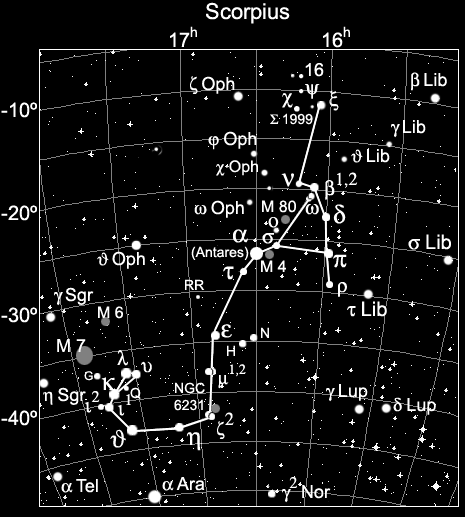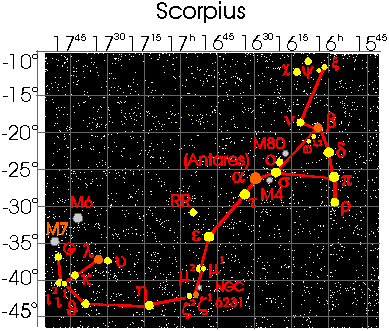
Scorpius is a mid-Spring constellation with a number of interesting objects. For small telescopes and binoculars there are several star clusters of interest.

Alpha Scorpii is Antares: "the rival of Mars". Antares is a red giant, more than 300 times the size of the sun. The name refers to its colour, a unique glittering metallic red. Antares is easily found in the mid-Spring skies, to the southeast of Spica. It makes a large triangle with Vega and Arcturus and is one of the pointer stars in the summer skies in the northern hemisphere. In the same field as Antares is the star cluster M4, although its individual stars won't be resolved in binoculars
Beta Scorpii is an attractive binary for small telescopes or large binoculars. Beta is eight degrees northwest of Antares (just over one FOV). It forms a distinctive asterism with its neighbours. In the same field is nu Scorpii, a quadruple system suitable for medium sized scopes although large binoculars might show the two brightest members (4.4, 5.4).
Lambda Scorpii is the tip of the scorpion's stinger.
The stinger is formed by theta and several fainter stars, ending with lambda and the fainter upsilon. From zeta move east one field, then you'll see the asterism, as the stars curl up to form the stinger.
Zeta1 Scorpii is the base of the scorpion's tail. Despite sharing its name with the close-by zeta2, the two stars do not form a true binary. Zeta1 is the brightest member of a fine star cluster, NGC 6231, a naked eye star cluster of over a hundred stars, well seen in binoculars. To locate the cluster, drop southeast of Antares three FOV.
